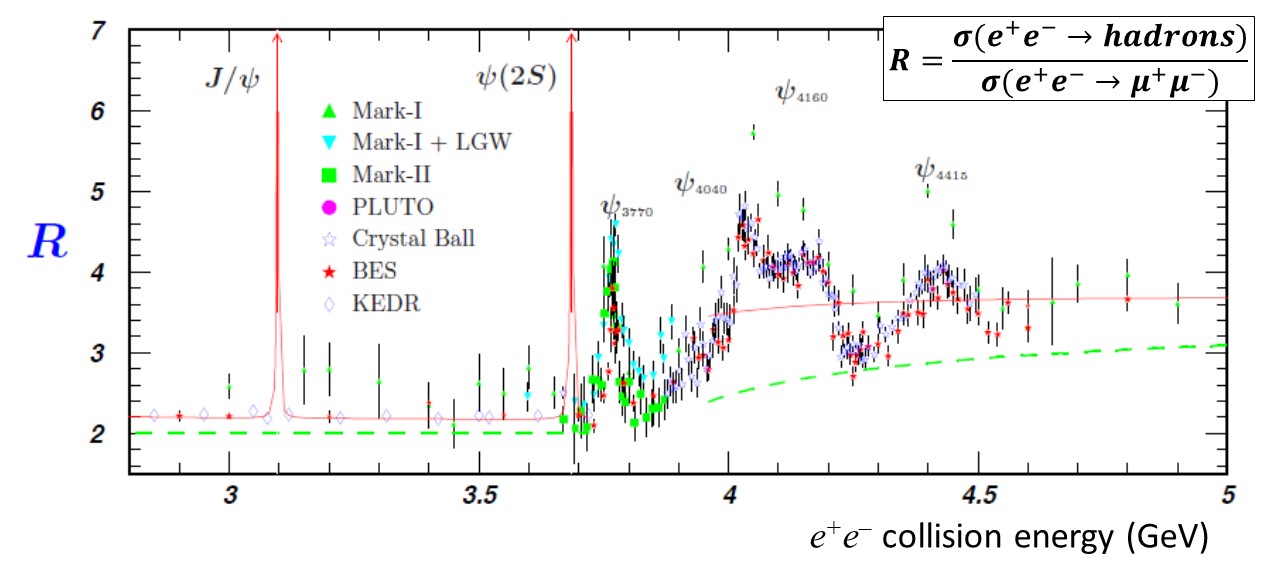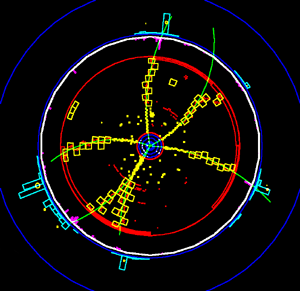
In 2003, CLEO switched operation from its primary beauty quark physics to running near the threshold for production for charm mesons. The figure above shows a scan of e+e- collision energy, where at each energy the experiment measures the ratio of production cross-sections for hadrons versus pairs of muons. Several prominent features are seen:
- Very large cross-sections at about 3.1 GeV and 3.68 GeV, corresponding to the production of the J/Ψ and Ψ(2S) particles, which are the first and second radial excitations of the bound state of a charm and anti-charm quark (cc). The cc bound states are often referred to as charmonium (analogous to positronium being an e+e- bound state). These resonances cannot decay into a pair of charm mesons because the lightest charm meson (D0) has a mass of 1.865 GeV, and thus the resonance cannot decay into a D0D0 meson pair.
- Higher mass ψ states ψ(3770), ψ(4040), ψ(4160), ψ(4415) are seen, which have sufficient mass to decay into a DD meson pair.
- Overall, an increase in R from ~2.2 (below 3 GeV) to ~3.7 (above 3.9 GeV). This occurs because below 3 GeV, the only quark pairs that can be produced are uu, dd, ss, but above about 4 GeV, there us sufficient energy to also produce a pair of charm mesons as well (e.g. through the production of a cc pair), which increases the numerator of R accordingly.
-
-
CLEO-c took data in this energy region. In addition to exploring the spectrum of charmonium states, CLEO-c took data on the peak of the higher mass charmonium resonances to produce very large samples of charm mesons near threshold. Much of the data collected was at the ψ(3770), and this resonance decays to predominantly to a pair of charm mesons. When this occurs, there is insufficient energy to produce any other hadrons, so the event is very “clean”. There is a D and a D (both of which decay), and nothing else. An event display showing the side view of an e+e- collision that produced a DD pair is shown below. The six curved lines shown are the reconstructed trajectories of 6 particles produced in the decay of the D and D meson.
This allowed some world-class measurements to be made, including
-
- Absolute branching fractions of many D and Ds mesons;
- Measurement of the decay rates of the purely leptonic decays, D+→μ+νμ and Ds+→μ+νμ, and determination of the associated decay constants;
- Measurements of the average strong phase differences between D and D in D → KSπ+π–, which is a key ingredient to measuring the weak phase γ in B+ → DK+, where D → KSπ+π–;
- Numerous studies of semileptonic decays, which served as important input to Lattice QCD;
- Observation of quantum correlations in production of DD meson pairs;
- Observation of the DsJ(2463) and confirmation of the DsJ(2317);
- + much more
You can find more information on CLEO-c public results at this page.

